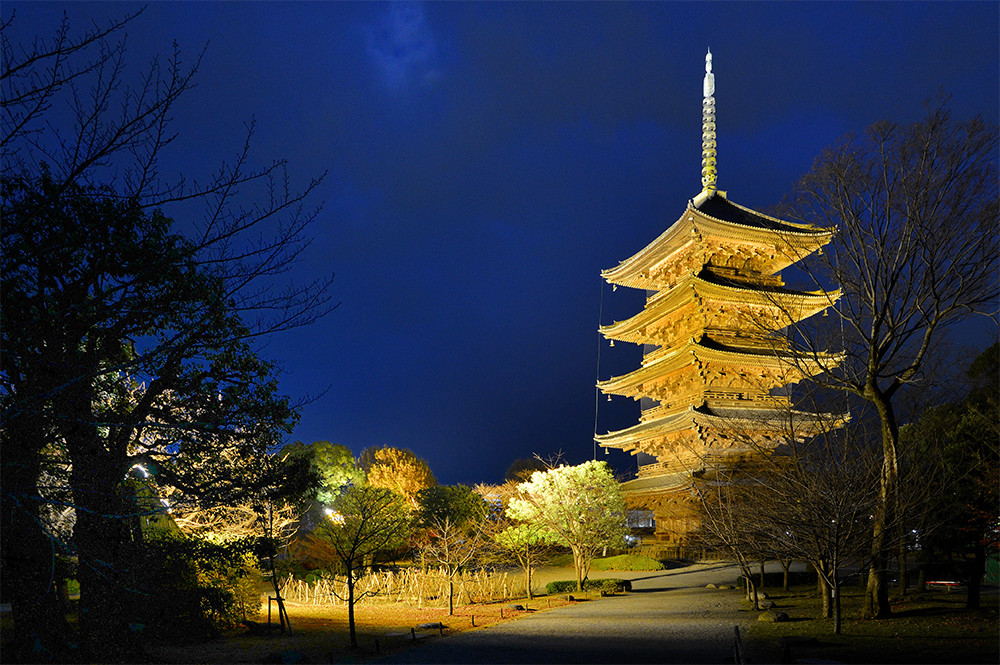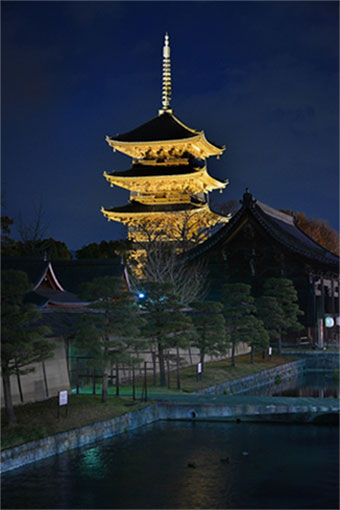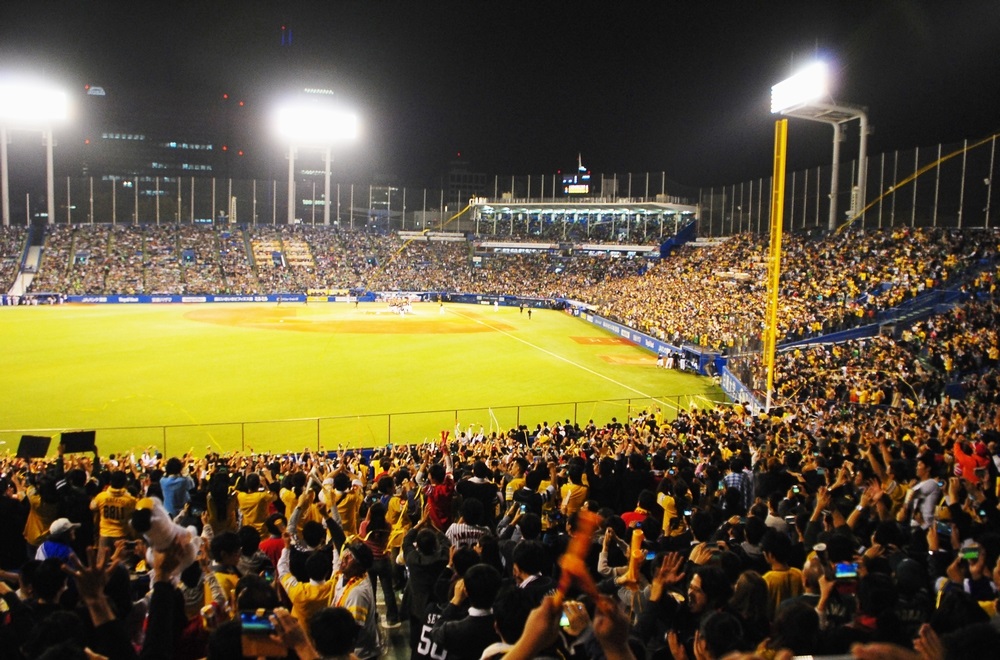Meticulously Designed Illumination:To-ji Temple Brightens up Kyoto Evenings
2018/12/12 Toshiba Clip Team

To-ji Temple has stood in Kyoto since the days when the ancient city was called Heiankyo. Founded over 1,200 years ago, To-ji, or to give it its full name, Kyo-o-gokoku-ji Temple, is a UNESCO World Heritage Site. Celebrated for its five-story pagoda, To-ji is an iconic feature of the Kyoto cityscape, and also noteworthy as Japan’s first temple associated with Esoteric Buddhism.
The pagoda is illuminated throughout the year, with special evening viewing of cherry blossom in the spring and of the vivid autumnal displays the foliage creates in the fall. During these seasons, the trees in the exquisite temple garden are also illuminated. To-ji attracts numerous visitors eager for an unforgettable close-up view of the pagoda illuminated against the evening sky.
State-of-the-art LED illumination technology reveals this architectural gem. While presenting the dramatic traditional image of the golden five-story pagoda etched against the evening sky, power consumption is remarkably reduced in line with contemporary priorities. This article focuses on the behind-the-scenes efforts to achieve perfection.
Optimization of light intensity and color
“HID lamps* were previously used to illuminate the pagoda at To-ji. Discussion on an LED-based replacement lighting system that would consume far less power began in 2012, but back then LED could not yet reach the same level of light intensity and color as HID lamps. The big challenge was how to present the golden image of To-ji’s pagoda.” (Ms. Asuka Ootani, Toshiba Lighting & Technology Corporation)
*HID lamps: High-intensity discharge lamps. HID lamps include mercury-vapor lamps, metal-halide lamps and high-pressure sodium lamps.
On receiving the inquiry about using LED, Toshiba Lighting & Technology swung into action, holding a series of experiments at To-ji featuring the latest LED projectors. On their many visits to To-ji, the team repeatedly adjusted the equipment in the limited time available, from dusk until nightfall, while the temple was closed to the public.
The LED projectors used in the initial experiments were the best then available in terms of maximum output. Although it was confirmed that the required light intensity could be achieved by increasing the number of lights, color temperature was high and illumination was bluish white, falling far short of what was desired. Even if power consumption could be greatly reduced, LEDs would have been a nonstarter if they could not achieve an illumination color capable of presenting the golden five-story pagoda in all its glory.

Special samples were trial manufactured to realize the optimum brightness and the optimum color.
“We prepared four types of prototypes, three units of each. Employing them in various combinations, we meticulously checked the appearance of the foreground and more distant views of the pagoda. Progressing by trial and error, we eventually attained the optimum combination. Using light-bulb-colored LED projectors with incandescent color (3,000 K) and dark orange LED projectors (2,000 K) at a ratio of 1:2, we were able to present the golden five-story pagoda in all its entrancing beauty.” (Ms. Tomoko Kodama, Toshiba Lighting & Technology Corporation)
The front of To-ji is the southern aspect where the Southern Gate is situated. However, as a magnet for tourists, the northern aspect, that is, the view from the north or from the direction of Kyoto Station, is important. So 15 projectors are installed northeast and northwest of the pagoda, respectively, and six southeast and southwest, respectively, to achieve a balance between the northern and southern aspects. The golden five-story pagoda illuminated against the night in Kyoto is a resoundingly successful fusion of cutting-edge technology, meticulous design and timeless aesthetics.

The five-story pagoda viewed from the southwest
LED expands the possibilities of illumination
“LED slashed power consumption by 51%. And with the previous lighting, the balance of the color tone sometimes got lost when replacing a lamp. In contrast, long-life LED lamps offer stable light color for a long period of time without any need for replacement.” (Ms. Kodama)

LED projectors with life of 60,000 hours (about five times longer than the previous lighting equipment)
Illumination of the five-story pagoda at To-ji has generated a great deal of favorable interest, opening up opportunities for Toshiba Lighting & Technology to apply its expertise in various scenes—cherry blossom, vistas of autumn foliage, statues of the Buddha in temples, and much more.
As well as drastically cutting power consumption, LED lamps can realize presentations far superior to those attainable with other light sources. For illumination projects in which sophisticated aesthetic effects are sought, LED has a particularly bright future. Toshiba Lighting & Technology’s expertise in illumination can not only add renewed luster to sightseeing spots and commercial facilities but also help vitalize communities.

Ms. Asuka Ootani (left) and Ms. Tomoko Kodama (right), Toshiba Lighting & Technology Corporation.
They visited To-ji Temple many times not only prior to installation of the LED projectors but also subsequently for fine-tuning. When taking the Shinkansen bullet train in the evening, they always occupy Seat A, which offers a superb view of the northern aspect of To-ji Temple, just to check the illumination.
![]()







